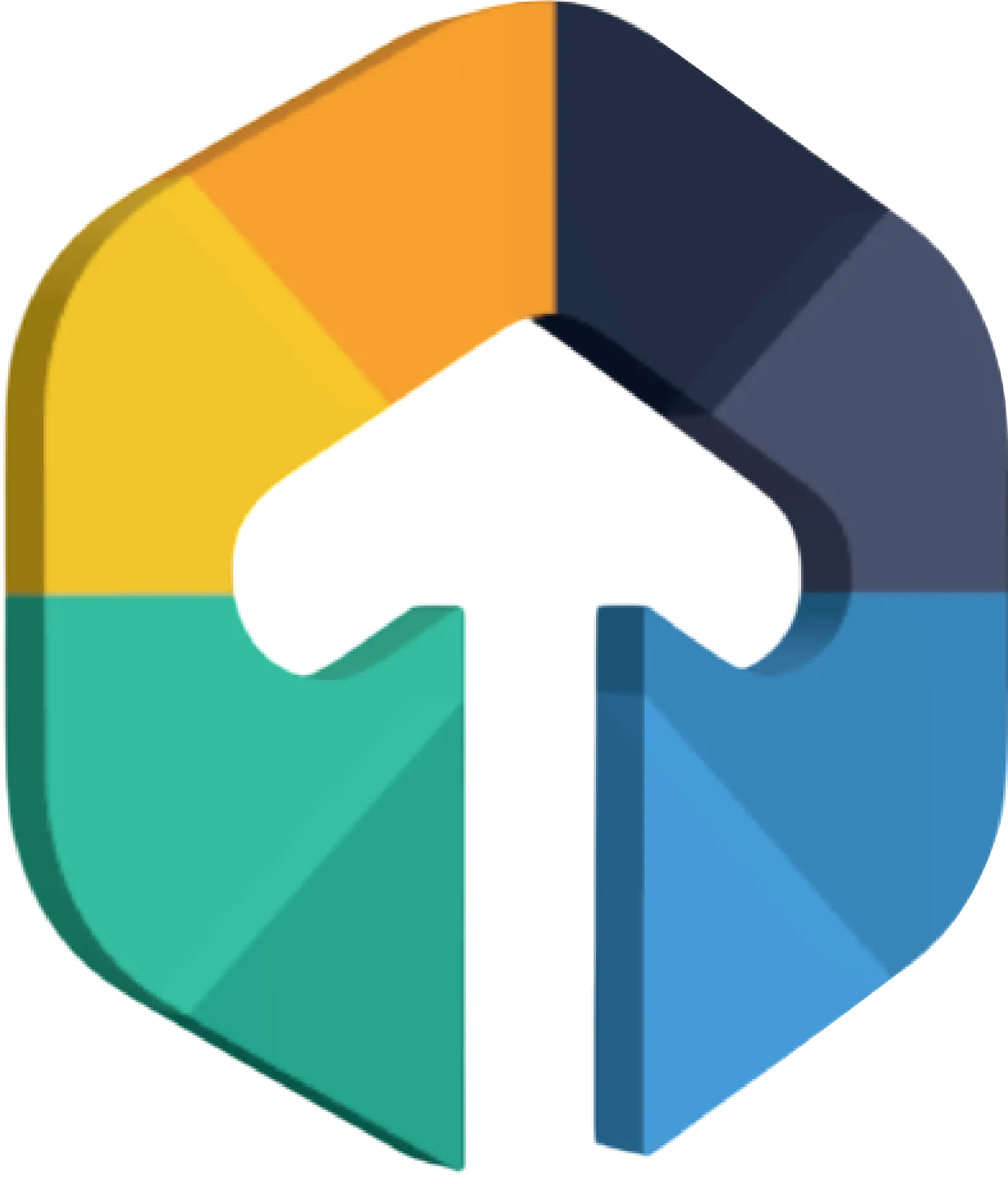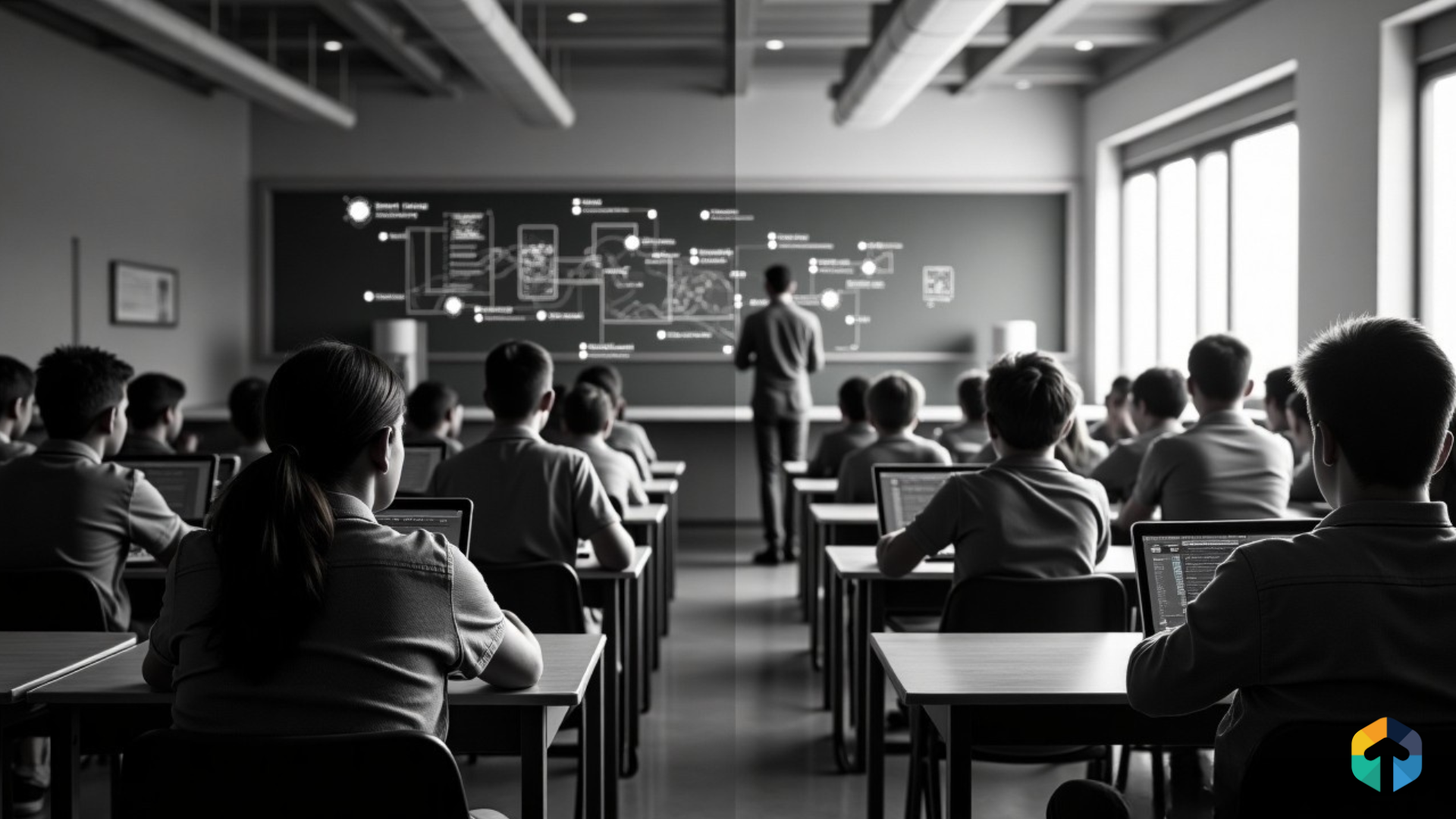
TL;DR: Key Takeaways
What It Is: Adaptive learning technology uses AI to personalise education in real-time, adjusting content, pacing, and assessments for each individual student.
Why It Matters: Traditional one-size-fits-all education fails 70% of students. Even genius-level learners need personalised instruction to reach their full potential.
Proven Results:
- Average grade improvement per lesson
- Better student engagement rates
- Better course completion rates
- Significant equity improvements for underserved populations
Business Impact: Improved student outcomes, reduced remedial costs, better resource allocation, enhanced teacher effectiveness, and measurable ROI through higher retention rates.
Implementation: Start with pilot programs, invest in teacher training, choose platforms with true AI (not fake "adaptive" tools), and plan a 2-3 year gradual rollout.
Bottom Line: Adaptive learning isn't optional anymore; it's essential infrastructure for competitive educational institutions serious about student success and operational efficiency.
Picture this: A classroom where every student receives exactly the right lesson at precisely the right moment, where struggling learners get additional support without feeling left behind, and where gifted students are challenged without being held back. This isn't educational fantasy. It's the reality that adaptive learning technology is creating in classrooms worldwide.
The most compelling evidence comes from an unexpected source. A groundbreaking 45-year study called the Study of Mathematically Precocious Youth (SMPY) tracked 5,000 of America's brightest, the top 1%, 0.1%, and even 0.01% of all learners. The shocking discovery? Even these genius-level students needed personalised guidance and individualised instruction to reach their full potential. Those who received tailored educational experiences were 60% more likely to earn patents and doctorates.
If personalisation matters this much for the brightest minds, imagine its impact on every student in your classroom.
The Personalisation Crisis in Modern Education
Traditional education operates on a fundamentally flawed assumption: that all students learn the same way, at the same pace, with the same methods. Yet every educator knows this couldn't be further from the truth.
In a typical classroom of 30 students, you'll find learners who grasp concepts instantly alongside those who need additional practice, visual learners mixed with auditory processors, and students with vastly different cultural and linguistic backgrounds.
Educational technology has promised solutions for decades, but too often, these tools simply digitise the same one-size-fits-all approach. Enter adaptive learning a revolutionary methodology that doesn't just use technology in education, but fundamentally re-imagines how learning happens.
What is adaptive learning technology?
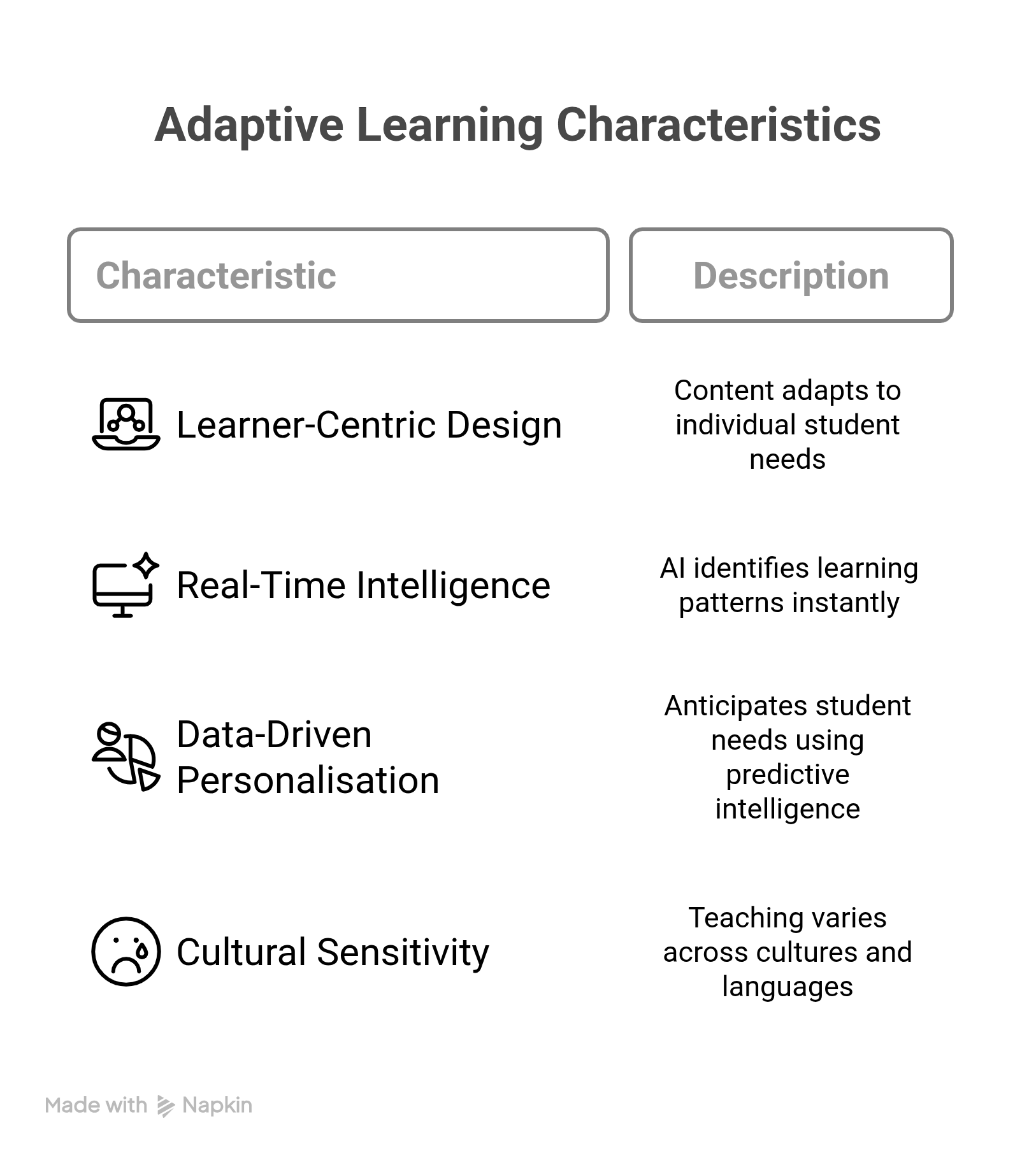
At its core, adaptive learning is an educational methodology that leverages artificial intelligence and machine learning to personalise learning experiences for individual students in real-time.
Unlike traditional digital learning tools that follow predetermined paths, adaptive learning systems continuously analyse student performance, engagement patterns, and learning preferences to dynamically adjust content, pacing, and instructional approaches.
Think of it as having a master teacher who instantly recognises when a student is struggling with fractions, understands exactly why they're confused, and immediately provides the perfect combination of visual aids, practice problems, and scaffolding exercises. But this "teacher" never gets tired, never overlooks a student, and can simultaneously personalise learning for hundreds of learners.
Key Characteristics of Adaptive Learning
Learner-Centric Design: The technology bends to meet student needs, not the other way around. Content adapts to each learner's zone of proximal development—that sweet spot where learning is challenging but achievable.
Real-Time Intelligence: Using educational AI, the system continuously processes data about how students interact with content, identifying patterns invisible to human observation. Is a student rushing through material without comprehension? Are they spending excessive time on concepts they've already mastered? The AI notices and adjusts instantly.
Data-Driven Personalisation: Every click, pause, correct answer, and mistake becomes data that informs future learning paths. This isn't just learning analytics, it's predictive intelligence that anticipates student needs before problems arise.
Cultural Sensitivity: The best adaptive learning software recognises that effective teaching varies across cultures, languages, and learning communities. It adapts not just to individual cognitive patterns but to cultural contexts that influence learning.
Start Small, See Big Results
Pilot adaptive learning in just one classroom and track real-time improvements.

The Technology Behind Educational Transformation
Modern adaptive learning platforms employ machine learning algorithms that process enormous amounts of educational data. These systems analyse patterns from thousands of previous learners to understand how different types of students respond to various instructional approaches. When a new student exhibits similar patterns, the AI can predict which methods will be most effective.
For example, if the system detects that visual learners in algebra consistently struggle with word problems but excel when the same concepts are presented through geometric representations, it will automatically shift struggling students toward visual approaches while maintaining algebraic rigour.
Real Time Assessment and Adjustment
Traditional assessment happens after learning, think end-of-chapter tests or quarterly exams. Adaptive assessment tools embed evaluation seamlessly into the learning process. Every interaction becomes a micro-assessment that informs the next learning moment.
This continuous feedback loop enables what educators call "just-in-time" intervention. Instead of discovering learning gaps weeks later through summative assessments, teachers receive immediate alerts when students need support, allowing for timely intervention that prevents small struggles from becoming major learning deficits.
Learning Analytics Dashboards
Real-time learning analytics for educators transform how teachers understand their classrooms. Sophisticated dashboards reveal insights like
- Which concepts are causing widespread difficulty across the class?
- Individual students who may need additional support or acceleration.
- Optimal timing for introducing a new concept based on class readiness.
- Effectiveness of different teaching materials and approaches.
Types of Adaptive Learning Customisations
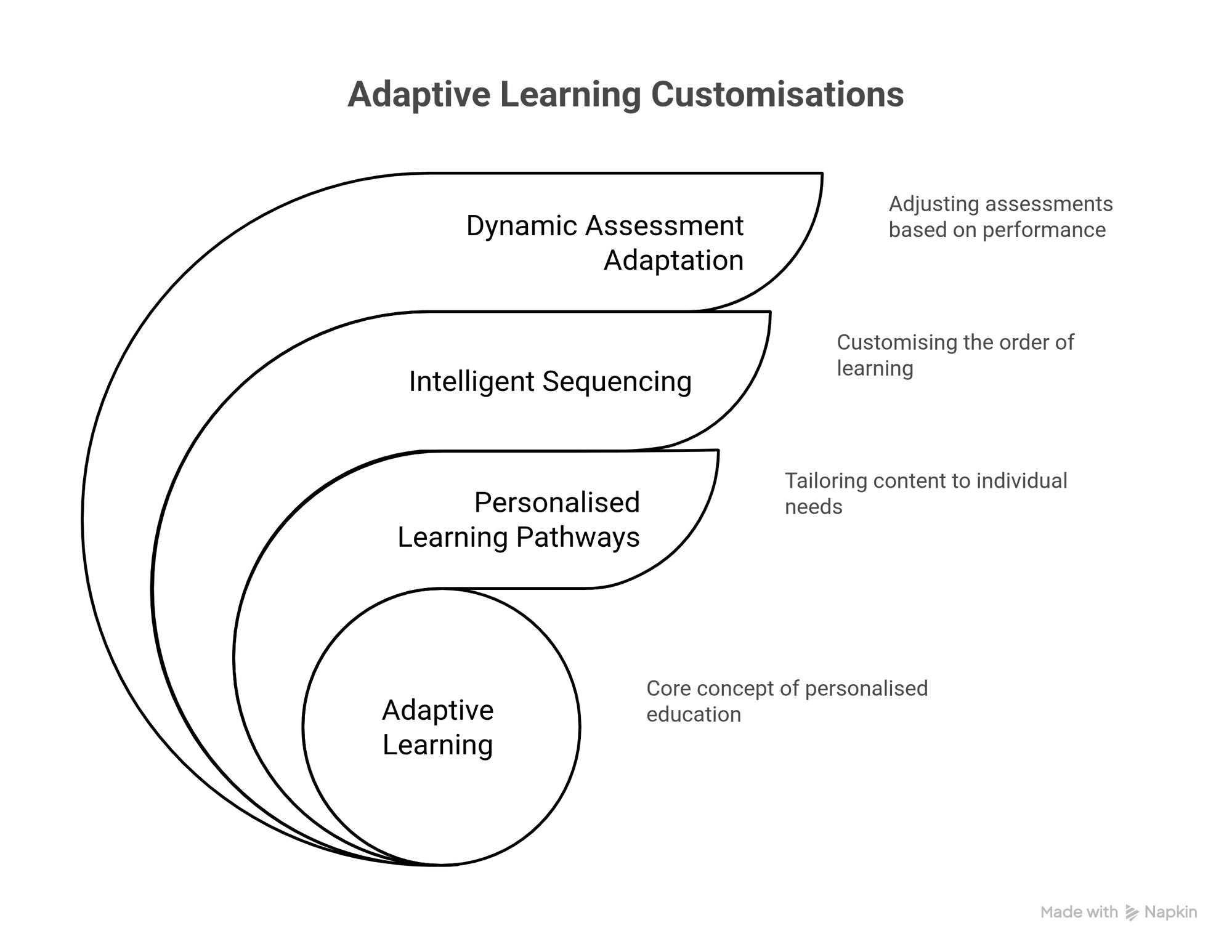
Personalised learning pathways adjust not just what students learn, but how they learn it. Visual learners might receive the same algebra concept through interactive graphs and geometric representations, while analytical learners get step-by-step logical proofs. Kinesthetic learners could manipulate virtual objects to understand the same mathematical relationships.
This isn't about dumbing down content. It's about presenting rigorous academic material in ways that connect with individual learning preferences and strengths.
Intelligent Sequencing
Traditional curricula follow linear progressions, where students typically move from Chapter 1 to Chapter 2, and then to Chapter 3. Adaptive learning technology recognises that learning isn't linear. Some students might master advanced concepts while still struggling with foundational skills. Others might need to revisit basic concepts multiple times before they're ready for advancement.
Intelligent sequencing creates individualised learning progressions that ensure true mastery while maintaining appropriate challenge levels. A student might work on advanced probability while simultaneously receiving additional practice with basic fractions, whatever combination optimises their learning trajectory.
Dynamic Assessment Adaptation
Adaptive assessment tools for teachers revolutionise how we measure student understanding. Instead of identical tests for all students, adaptive assessments adjust question difficulty in real-time based on student responses.
If a student demonstrates mastery of basic concepts, the assessment automatically presents more challenging problems.
If they struggle, it provides additional scaffolding questions to pinpoint exactly where understanding breaks down.
This approach provides far more precise diagnostic information while reducing test anxiety and improving the overall assessment experience.
Transforming Teaching and Learning: Real Classroom Impact

Self-Directed Learning with Clear Progress Visualisation
Students using adaptive learning platforms report higher levels of agency over their education. Instead of wondering "Am I getting this?" they receive continuous feedback about their progress, areas of strength, and growth opportunities. This metacognitive awareness, understanding how they learn, becomes a lifelong skill.
One of the most powerful aspects of technology-enhanced learning is that students can progress at optimal speeds without leaving their peer groups. A mathematically gifted student can accelerate through arithmetic while remaining with age-appropriate peers for social studies and language arts.
Increased Engagement Through Personalised Challenges
Generic worksheets bore advanced students and overwhelm struggling learners. Adaptive systems provide content at each student's optimal challenge level, difficult enough to promote growth but achievable enough to maintain confidence and motivation.
Benefits for Educators

Real-Time Classroom Oversight
Teachers gain unprecedented insight into student thinking processes. Instead of discovering misconceptions during grading, they can identify and address problems as they emerge. This shifts teaching from reactive to proactive.
Data-Driven Instructional Decisions
Gut feelings and assumptions give way to evidence-based teaching strategies. Analytics reveal which instructional approaches work best for different types of learners, allowing teachers to continuously refine their practice.
Scalable Personalisation
The holy grail of education, meeting every student's individual needs, becomes achievable without overwhelming teacher workload. Technology handles the heavy lifting of content customisation, freeing teachers to focus on relationship building, creative instruction, and complex problem-solving support.
Administrative and Institutional Benefits
Improved Student Outcomes and Retention
Institutions implementing adaptive learning technology in higher education report significant improvements in course completion rates, particularly among historically underserved populations. When learning experiences match student needs, dropout rates decrease and academic success increases.
Cost-Effective Resource Allocation
Traditional interventions like tutoring and remedial courses become more targeted and effective. Instead of broad-brush approaches, resources can be precisely directed where they'll have maximum impact.
Evidence-Based Curriculum Development
Continuous data collection provides unprecedented insights into curriculum effectiveness. Which topics consistently challenge students? What sequence of concepts optimises learning? These questions get answered through real classroom data rather than theoretical assumptions.
Real-World Implementation Success Stories
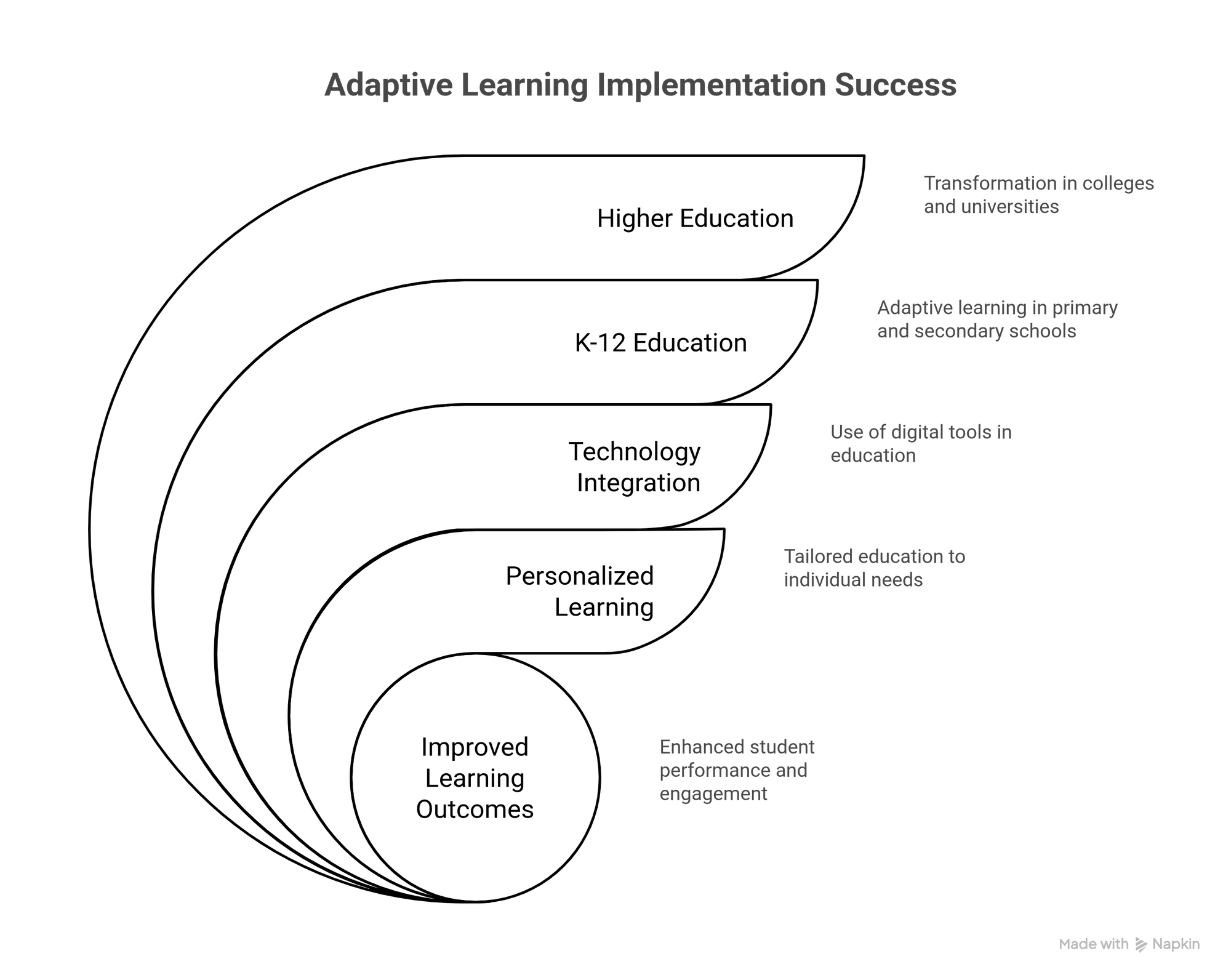
K-12 Applications
Learning.com's EasyTech program showcases the power of adaptive learning in K-12 digital literacy education. Students develop keyboarding, online safety, and computational thinking skills through personalised pathways that adapt to individual progress and learning styles. Schools report not just improved technical skills, but increased confidence and engagement with technology.
Higher Education Transformations
University of Central Florida transformed foreign language instruction by implementing adaptive learning software alongside open educational resources. Students progressed through language acquisition at individualised paces while maintaining social learning opportunities through collaborative projects and peer interaction.
Community College Success: Multiple community college systems have used adaptive learning to address the challenge of diverse student preparation levels. By providing personalised mathematics instruction that meets students where they are academically, these institutions have dramatically improved success rates in gateway courses.
Multi-Campus Coordination
Cuyahoga Community College faced the challenge of ensuring consistent quality across multiple campuses with heavy reliance on adjunct faculty. Adaptive learning platforms provided standardised yet personalised learning experiences, allowing eight adjunct faculty teaching the same business course to deliver consistent, high-quality instruction regardless of their individual teaching experience.
Addressing Implementation Challenges
The adaptive learning market includes many products that promise personalisation but deliver little more than digital worksheets. How do I choose adaptive learning technology?

Start by asking these critical questions:
- Does the system actually change content and pacing based on individual student performance?
- Are the algorithms transparent and based on educational research?
- Can teachers access meaningful analytics that inform instruction?
- Does the platform support diverse learning styles and cultural contexts?
True adaptive learning requires sophisticated AI that goes far beyond simple branching scenarios or randomised question banks.
Combating Algorithmic Bias
Avoiding algorithmic bias in education technology requires intentional effort. AI systems learn from historical data, which may reflect past inequities and biases. Educational leaders must ensure that adaptive learning implementations actively promote equity rather than perpetuating existing disparities.
This means selecting platforms that have been tested across diverse student populations, regularly auditing outcomes for different demographic groups, and maintaining human oversight of algorithmic decisions.
Change Management and Professional Development
Successful implementation requires more than technical training. Educators need support in
- Interpreting and acting on learning analytics data.
- Integrating adaptive learning with existing instructional practices.
- Managing classroom dynamics when students work on individualised content.
- Communicating with parents about personalised learning approaches.
Change management should be gradual, allowing teachers to build confidence and competence over time rather than overwhelming them with wholesale instructional transformation.
Selection Criteria for Adaptive Learning Tools
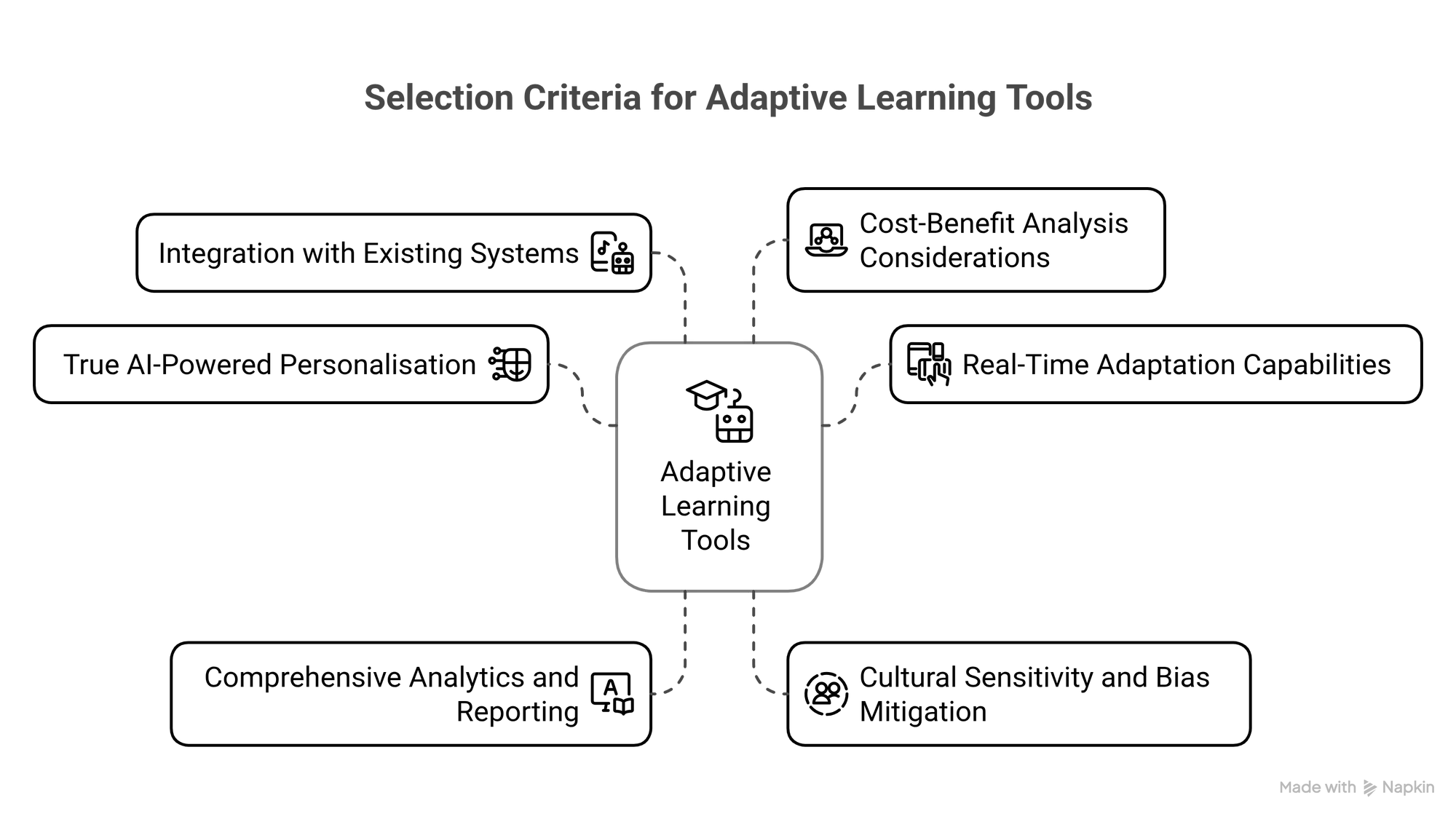
- True AI-Powered Personalisation: Look for platforms that use sophisticated machine learning algorithms, not simple rule-based branching. The system should learn from student interactions and improve its recommendations over time.
- Real-Time Adaptation Capabilities: Content and pacing should adjust continuously based on student performance, not just at predetermined checkpoint assessments.
- Comprehensive Analytics and Reporting: Teachers and administrators need actionable insights, not just data dumps. Look for dashboards that highlight priority students, suggest interventions, and track progress toward learning objectives.
- Cultural Sensitivity and Bias Mitigation: The platform should be designed to work effectively across diverse student populations and include features to identify and address potential bias in algorithmic decision-making.
- Integration with Existing Systems: Adaptive learning platforms should seamlessly integrate with existing learning management systems (LMS) and student information systems to avoid creating additional administrative burden.
Cost-Benefit Analysis Considerations
ROI of adaptive learning in schools extends beyond immediate academic improvements.
Consider:
- Reduced need for remedial instruction and tutoring.
- Improved student retention and graduation rates.
- Enhanced teacher effectiveness and job satisfaction.
- Better resource allocation based on data-driven insights.
- Long-term improvements in student preparedness for advanced coursework.
While initial implementation costs may seem significant, the long-term benefits often provide substantial return on investment, particularly when considering the costs of student failure and dropout.
Get Your Free Adaptive Learning Checklist
Everything you need to launch your first program with confidence.

The Future of AI in Classroom Instruction
The next generation of adaptive learning technology will incorporate even more sophisticated AI capabilities. Predictive analytics will identify students at risk of academic difficulty weeks or months before problems manifest. Natural language processing will enable more nuanced assessment of student understanding through written responses and verbal interactions.
Virtual and augmented reality integration will create immersive learning experiences that adapt not just content but entire educational environments to individual learning preferences and needs.
Integration and Blended Learning Models
Blended learning approaches that combine face-to-face instruction with adaptive digital experiences represent the future of education. Students might receive personalised practice and content introduction through adaptive platforms while engaging in collaborative problem-solving and discussion in physical classrooms.
This hybrid approach maximises the benefits of both human instruction and artificial intelligence, creating learning experiences that are both deeply personal and richly social.
Scalability and System-Wide Implementation
As adaptive learning platforms mature, we're seeing movement toward district-wide and even state-wide implementations. This scalability promises to democratise access to personalised learning, ensuring that high-quality, individualised instruction isn't limited to wealthy districts or elite institutions.
Getting Started: A Practical Implementation Roadmap

Begin by conducting a thorough analysis of current educational challenges and student needs. What are your biggest instructional pain points? Where do students consistently struggle? Which populations are underserved by current approaches?
Use this assessment to identify specific goals for adaptive learning implementation. Are you primarily focused on improving remedial education? Accelerating gifted learners? Reducing achievement gaps? Clear objectives will guide platform selection and implementation strategies.
Pilot Program Development
Start small with a carefully designed pilot program. Choose a single course or grade level where you can thoroughly test adaptive learning approaches and gather comprehensive data about effectiveness.
This pilot should include
- Baseline data collection on student performance and engagement.
- Careful selection of participating teachers who are enthusiastic about innovation.
- Regular feedback collection from students, teachers and parents.
- Systematic documentation of challenges and successes.
Professional Development Strategy
Professional development for adaptive learning should be ongoing and multifaceted. Begin with foundational training on adaptive learning principles and the specific platform being implemented. Follow up with regular coaching sessions where teachers can share experiences, troubleshoot challenges, and learn advanced features.
Create communities of practice where educators can collaborate and learn from each other's experiences with adaptive learning implementation.
Success Metris and Continuos Improvment
Measuring success in adaptive learning programs requires both quantitative and qualitative indicators.
- Academic performance improvements (test scores, course completion rates).
- Student engagement metrics (time on task, self-reported motivation).
- Teacher satisfaction and confidence with the technology.
- Parent and community feedback.
- Long-term outcomes (college readiness, career preparation).
Use this data for continuous improvements, regularly refining implementation approaches based on evidence of what works best in your specific context.
Talk to Our Experts
Let’s plan how your school can implement adaptive learning at scale efficiently and effectively.

Conclusion
We stand at a pivotal moment in educational history. The tools and knowledge needed to provide truly personalised learning experiences for every student are finally within reach. Adaptive learning technology isn't just an educational enhancement. It's becoming essential infrastructure for 21st-century learning.
When we match instruction to individual learning needs, students achieve more, engage more deeply, and develop greater confidence in their abilities. Teachers become more effective, administrators can allocate resources more strategically, and educational equity advances significantly.
But perhaps most importantly, adaptive learning helps us remember why we entered education in the first place to unlock the unique potential within every learner. When technology serves this fundamental purpose, it becomes not just a tool but a pathway to educational transformation.
Transform your classrooms with cutting-edge adaptive learning technology. Schedule your free consultation today and join the educational advancements that prioritise student success.
FAQs
How does adaptive learning work in classrooms?
Adaptive learning technology uses AI to personalize instruction in real-time. Unlike traditional teaching where all students receive the same lesson, adaptive learning platforms adjust content difficulty and pacing based on individual performance.
What are the best adaptive learning platforms for schools?
Popular educational AI tools include Knewton Alta (higher ed math), McGraw-Hill ALEKS (K-12 math/science), and Pearson MyLab (multiple subjects). Costs range from $50-150 per student annually for K-12 and $100-300 per course for higher education. The ROI of adaptive learning in schools typically justifies costs through improved retention and reduced remedial instruction expenses.
How can adaptive learning improve student outcomes?
AI-powered personalized learning solutions identify exactly where students struggle and provide targeted support before advancing to new concepts. Research shows struggling students demonstrate 15-25% greater improvement with adaptive learning compared to traditional instruction, particularly in math and reading. The technology builds confidence by ensuring success at each learning step.
What training do teachers need for adaptive learning?
Professional development for adaptive learning requires 20-30 hours of initial training covering data dashboard navigation, lesson plan adaptation, and managing individualized progressions. Teachers need skills in interpreting real-time learning analytics and integrating adaptive platforms with existing teaching practices.
Yes, adaptive learning technology benefits all students by addressing individual needs rather than learning style assumptions. The system personalizes based on actual performance patterns and engagement behaviors.

